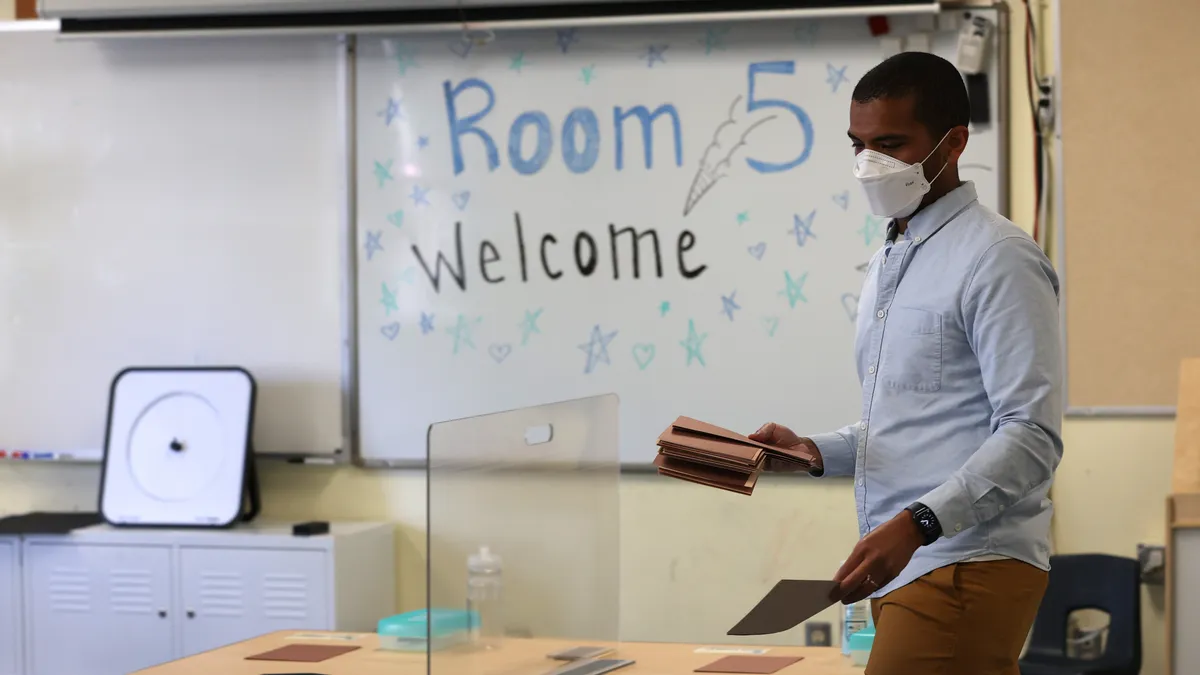Dive Brief:
- As classrooms continue to grow more racially diverse, schools need to support teachers who better reflect and represent their students, according to over 100 Black educators in a report by Teach Plus partnered with the Center for Black Educator Development.
- To create culturally affirming schools, the report calls for recruiting, supporting and retaining a diverse faculty and having school leaders actively foster an inclusive school culture with a culturally responsive curriculum. It’s also important all professional learning is equity-focused and that schools authentically carry out diversity, equity and inclusion efforts, the report said.
- As schools focus on recruiting teachers of color, they should be equally focused on retaining them, said Mark Teoh, Teach Plus vice president of learning, research, and impact and one of the report's lead authors. In fact, previous research has found Black teachers have higher turnover rates compared to other teachers.
Dive Insight:
Teachers of color have a 18.9% turnover rate, compared to 15% for their White peers, and Black teachers have one of the highest rates of turnover, according to the Institute for Research and Labor Employment. The Teach Plus report seeks to address this and other problems, even as outside forces in some communities organize against steps like the need for culturally responsive teaching, Teoh said.
The report found, in fact, that many teachers feel unwelcome in their workplace and that the school culture can even feel antagonistic, he said.
“From a teacher perspective, it’s very clear that when they feel that they can be their authentic selves in their work when they show up in the school building, that’s when it’s working,” Teoh said. “So when they feel like they can show up in all the different ways they feel is important, including who they are and what they teach, that is what success looks like and what an affirmative school culture looks like.”
Research also backs up a need for more Black teachers, as a working paper published this month by the Annenberg Institute at Brown University found. Matching students’ race with those of their teachers can help drive down rates of exclusionary discipline for Black and Latinx students.
Yet even as students of color increasingly appear in the classroom, the teaching workforce is not reflective of this trend, the report said. In 2017-18, the latest data from the National Center for Education Statistics, 79% of teachers were White, 7% were Black, 9% were Hispanic, 2% were Asian, 1% were American Indian/Alaskan Native, and 2% were two or more races, the NCES data showed.
Through focus groups of Black teachers, the Teach Plus report found that having a diverse faculty and teaching in a school with a diverse student population helped affirm Black teachers’ identities.
But as pushback against anti-racist discussions in schools and culturally responsive teaching practices circulates in some local communities, Teoh said it’s possible this movement could even worsen teacher retention rates of Black teachers and cause the exact opposite effect of what the report hopes for.
Even amid this climate, the work to create culturally affirming schools for teachers of color must not stop, said Erica Buchanan-Rivera, director of equity and inclusion at the Metropolitan School District of Washington Township in Indianapolis.
Buchanan-Rivera said it’s important for schools to establish learning partnerships with families and the community to help foster a culturally affirming school culture.
In her 12,000-student school district, Buchanan-Rivera said listen-and-learn spaces have been created through webinars hosted by the district for parents and caretakers. Overall, she said the response has been positive, and parents and caretakers have asked the district to hold more such webinars.
“If we are going to affirm the cultural identities of those that we are serving,” Buchanan-Rivera said, “then as educators we have to be responsive to the needs of individuals, which requires us to do self-work where we look in the mirror and we think about the ways in which we show up for students, we think about our biases, as well as how our beliefs of diversity align with our actions.”







 Dive Awards
Dive Awards







